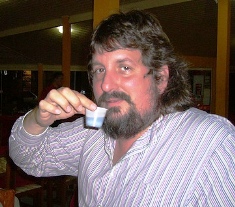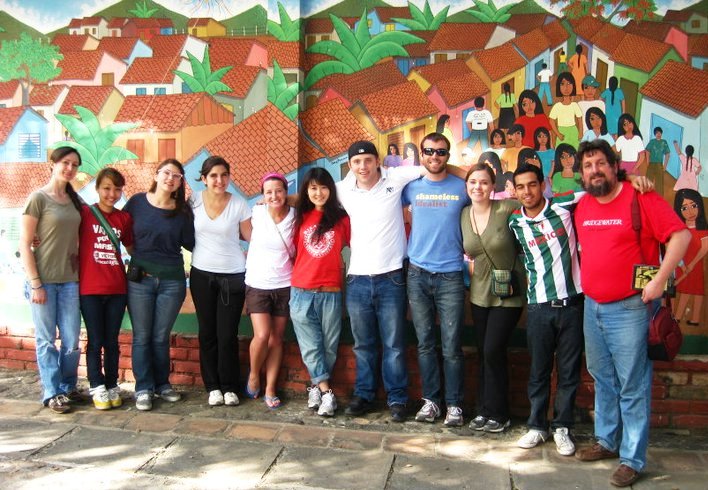Tour Overview
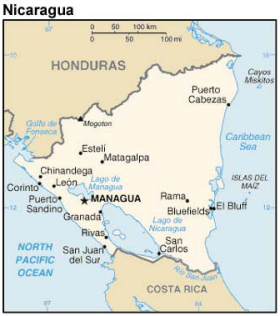
January 2 to 4:
León
Projects of the Polus
Center, including PLUSAA, Walking Unidos, and the Ben Linder
Café; Cerro
Negro
volcano
January 4
to 5:
Matagalpa
City of Matagalpa and Ben Linder grave site; CECOCAFEN
farmer-owned cooperative; volcanic geysers; weaving cooperative and
panoramic views at El Chile
January 5
to 7:
Selva
Negra
Selva Negra coffee estate and retreat; hiking in the Cerro El Arenal
reserve; visit to nearby farms including the award-winning organic
Aranjuez farm and a farm
meeting Starbucks "Cafe Practice" certification, but now selling to
smaller roaster
January 7 to 8: Peñas Blancas
Soppexo cooperative; Guardianes del Bosque cooperative; Ben
Linder's hydro-electric project at El Cuá
January 8 to 10: La Pita Community
Home stays
with coffee-farming families; coffee harvesting and wet-mill
processing; make traditional nacatamales
January
10
to
11:
Matagalpa
Meeting with farm-workers union; Castillo Cacao (Chocolate
Castle!); SOLCAFE dry mill, one of the first farmer-owned coffee
processing plants in the world; volcano Masaya
January
11
to
12:
Granada
City tour and Isletas de Granada
January
12 to
13:
Managua
Masaya volcano and market; tour and weekly lecture at Casa
Ben Linder
January 14: Boston
Return to Boston very early
in the morning!
|
The stories ...
This update is written from the
air, in what promises to be a terrific tour with ten students eager to
learn about Nicaragua and coffee. I always rely on my students at least
as much as they do on me, and from the students I learned that it was
possible to track our flight while on our flight. Within a minute, I
was able to capture the image below, showing that we were just passing
the southwestern tip of the Florida peninsula. And minutes after that,
I was able to post it for posterity and any friends who might be
curious as to where, exactly, we are!
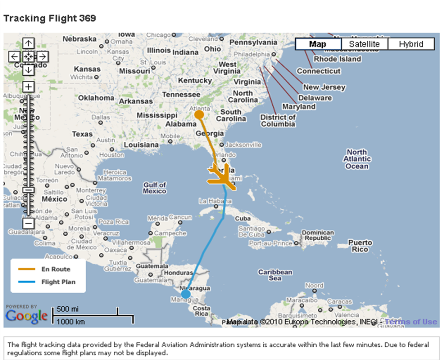
(Click to enlarge)
The communication,
navigation, and mapping technology involved in
making this small image boggles the mind. Integrated geotechnologies
are key industries of both the near and foreseeable futures.
In Leon, we visited projects of the Polus Center for Social and
Economic Development, whose international director is a BSU graduate. ( These projects are described in the 2010
trip page.) We also visited various cultural and historic sites
in the city, including Leon's cathedral, the largest in Central
America. Near the front of the cathedral is the grave of Nicaragua's
national treasure, the poet Ruben Dario.
|
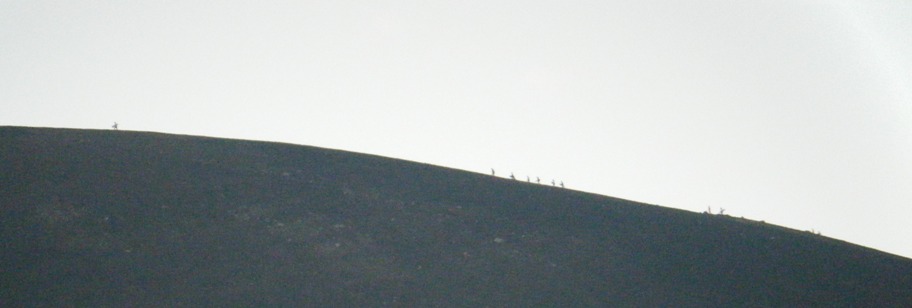
Cerro Negro is among the
world's youngest and most active volcanoes. Having emerged in the
past two centuries and erupted as recently as 1999, it is far too young
to support coffee. For students studying the
geography of coffee, however, it is was a vivid reminder of the
importance of volcanoes to Nicaragua's position
as a world leader in coffee quality. In addition to the adventure of
climbing the volcano and sliding down on sand boards,
the students were able to see an entire line of volcanoes formed from
the regional subduction zone.
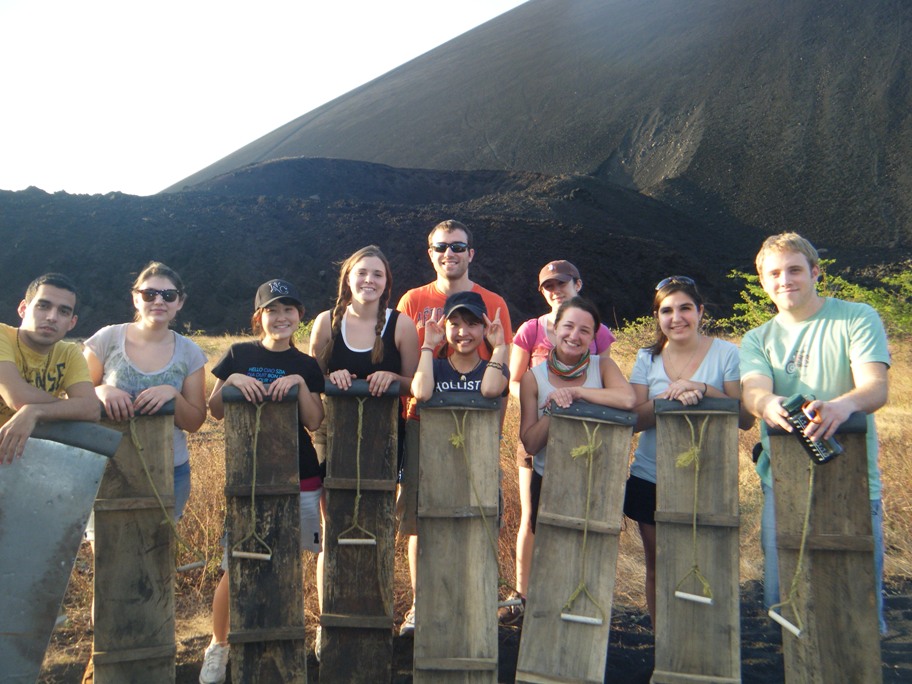
|
As Robert Burns said, to
see ourselves as others see us is a great gift. For those of us from
the United States, it is a gift that is all-too rare. We live at the
center of such a network of privilege that it is often difficult to
know how some of those privileges have been maintained. In the case of
Nicaragua, the history of its experiences with the United States in the
20th Century is well known throughout the country. In the U.S. itself,
however, it is a history that is conveniently forgotten.
In many ways, the relationship between the U.S. and Nicaragua is
improving, so it may
be jarring -- and certainly disconcerting -- to see
expressions that reflect a strong distaste for
the neocolonial excesses of the not-too-distant past. Given a
contemporary political climate in which conflicting
notions of equity and freedom are very much in play, Nicaragua's love
for linguistic and visual arts results in some rather compelling
imagery. The small mural to the right is a rich example. Found outside
a civil-defense office in Leon, it is in the form of a larger-than-life
shadow of the revolutoinary leader Sandino, who is best known for
having driven the U.S. Marines out of Nicaragua in the 1930s. (The
occupation of Nicaragua on behalf of fruit importers is a "detail" of
U.S. history that is somehow not always included in what we teach our
children.
In the late 1970s, another battle was waged in Sandino's name, between
the
dictator Samoza (whose father had killed Sandino many years before) and
a broad coalition of Nicaraguans. The Sandinista defeat of Samazo was
and is seen, however, as a defeat of the United States, which is
represented both by a humbled and gray Uncle Sam canine and by the
dollar on the opposite thigh.
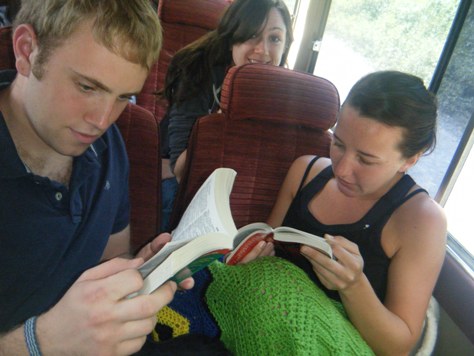
Although Spanish is not a prerequsite for the study tour, students at
every level of fluency learn the value of language learning (something
the current BSU curriculum wrongly ignores). This strong motivation
results in increased fluency for most students, mainly through
interactions with native speakers. During the 2011 tour, one of the
long bus rides between site visits proved to be a good time for some
vocabulary quizzing.
|
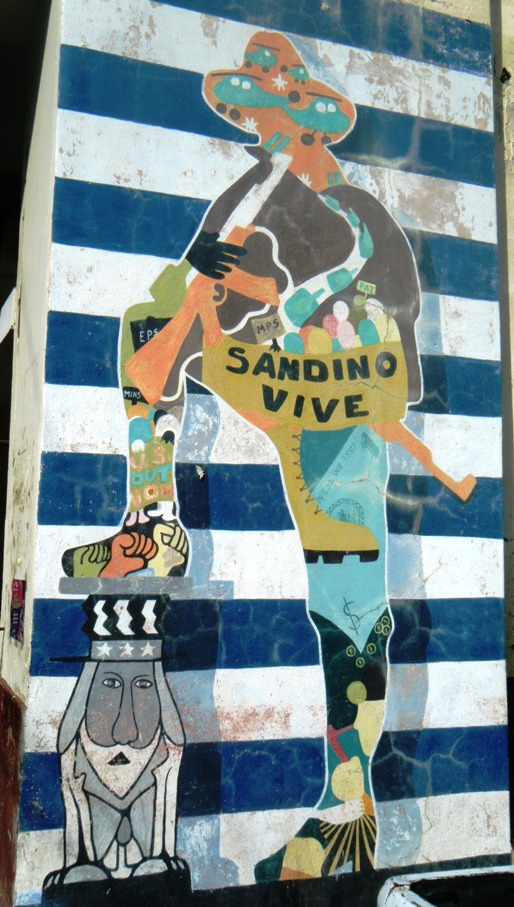
|
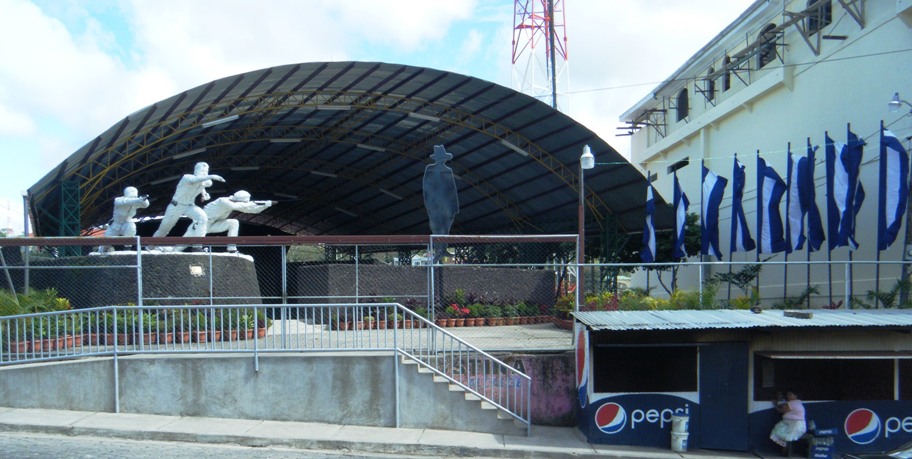
|
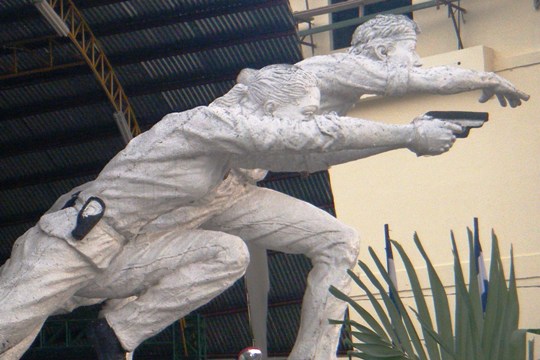
|
Public monuments can reveal a
lot about a place and about how the past
is -- or has been -- viewed in that place. References to the revolution
that led to the 1979 removal of Samoza can be found throughout
Nicaragua. During my first visit in 2006, a relatively conservative
government was in place at the national level, but revolutionary
iconography was quite prevalent in Matagalpa -- including the statue in
the town square depicting three guerrilla fighters. This statue is a
bit unusual among war memorials, in that it acknowledges the important
role of female fighters in the struggle.
Since the return of the Sandinista party (albeit in a more pragmatic
form), the pro-revolution signs and symbols have become far more common
than they were just a few years ago. Most notable is the sombra (shadow) of Sandino, which
previously was found only in Managua, where it looms over much of the
city. Smaller versions of that icon are now found in town squares
throughout the country.
|
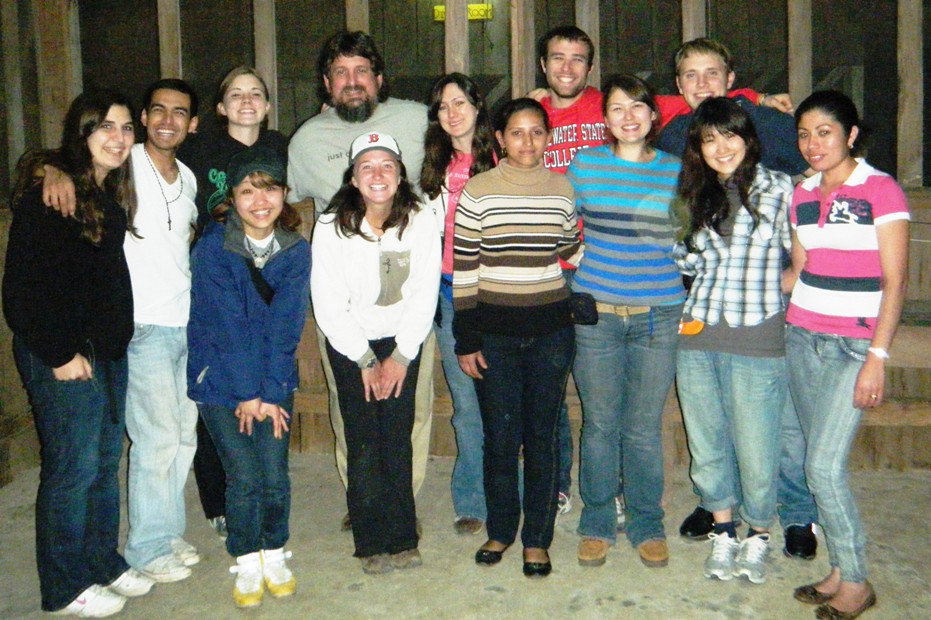
|
In commodity-dependent
communities,
economic diversification is a
critical aspect of economic development. Visitors are attracted to
Peñas
Blancas in the northern department Jinotega to visit coffee growers, Benjamin
Linder's hydroelectric
projects, and its towering white cliffs. The
community recently decided to offer
Spanish classes to visitors as part of diversification strategy that
has already begun to focus on tourism. Our Bridgewater State University
group (including the professor) had the honor of being the first
students to take classes with teachers Lilliam and Corina (front row, 1st and 4th from right).
The lesson was helpful for learners at all levels and a lot of fun.
Almost all coffee in Nicaragua is processed in two stages before being
exported. The first stage, know as the wet-mill process, involves
removing the outer skin of the coffee cherry (fruit) and using water to
ferment the slimy "honey" that coats the beans. Economic geography
posits that, all other things being equal, weight-losing processes such
as this should occur as near as possible to the source of the material.
The dry-mill process begins with coffee that has been peeled,
fermented, and rinsed. Spreading the coffee in the sun where it is
repeatedly raked and turned over until it reaches a low moisture level,
at which time the parchment layer is removed and the coffee is packaged
for export. This is also a weight-losing activity that should take
place as close as possible to the point of origin. High-grown specialty
coffees, however are grown in cloud forests, where dry mills would be
especially impractical. Farmers will, however, sometimes dry coffee in
small quantities for local use. In this case, coffee is being dried
immediately next to the restaurant where our group ate our meals -- and
drank coffee -- in Peñas
Blancas. |
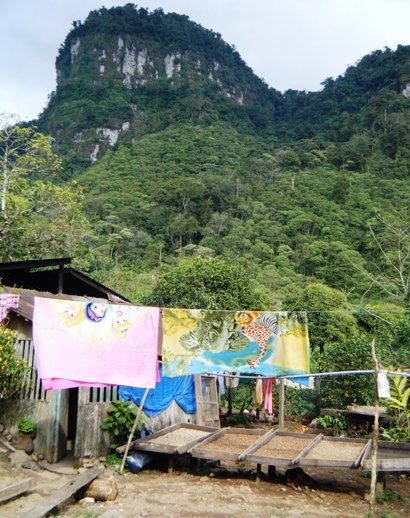 |
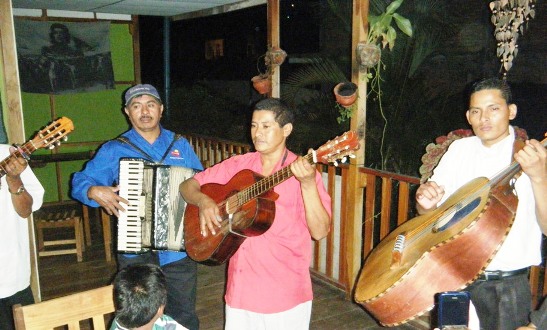
In Matagalpa, we usually enjoy a visit to a nice Italian restaurant
that has terrific pizzas and a pleasant open-air dining area upstairs.
Mariachis visit the tables, and play beautiful music for a lot less
than I have seen in similar settings in Mexico These mariachis are a
lot of fun, sometimes inviting our students to
play along. The young man at the right in this photo is playing a basso
sexto, a sort of double guitar that is very important in mariachi
and
Tejano music. I thought he looked familiar, and then I realized
why. On my first
study tour, he sold a basso sexto to one of my students, who carried it
like an extra passenger for the rest of our trip. I remember that it
got stuck in the x-ray machine at the Miami Airport. I can see that he
invested some of his proceeds in a replacement.
|
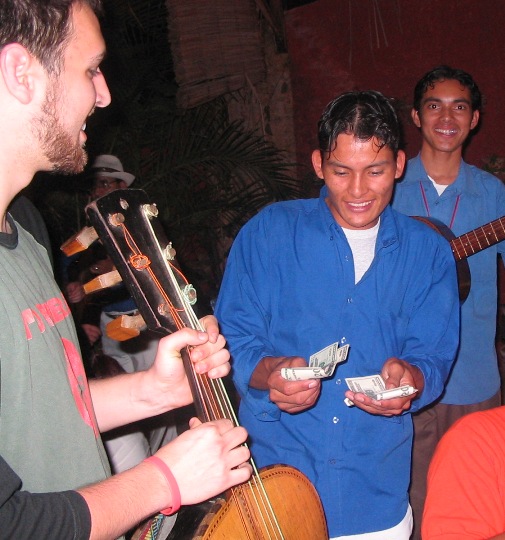
|
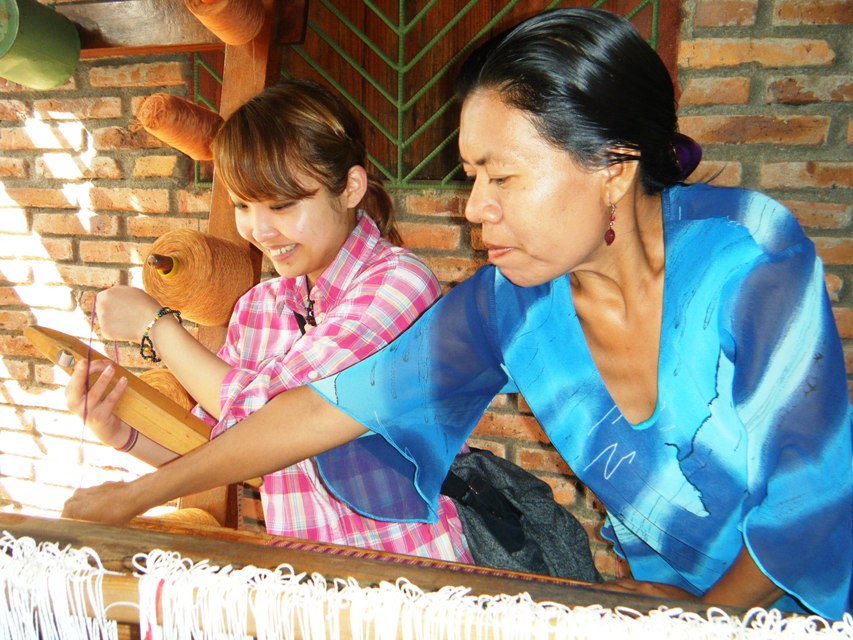
At the top of El Chile --
near a spectacular, 360-degree view of the coffeelands -- we visited a
weaving cooperative that we first encountered on the 2010 study tour.
Marta, an Argentine woman who had come to found the cooperative in the
1980s, has retired and moved away. The women she worked with, however,
are still weaving, and gave everyone in our group a bit of a weaving
lesson. Some of the handiwork of these women will be for sale BSU's Just
Trade Fair on April 14, 2011.
|
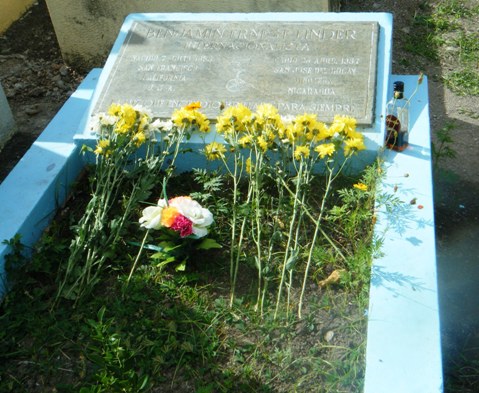
In Matagalpa, we visited the grave of Ben Linder, as we have on
previous journeys. In the past, we have often seen other cemetary
visitors honoring the deceased by cleaning, weeding, and leaving
flowers. This time, we decided to do the same, and also followed the
tradition of toasting the deceased with a sip of a beverage he enjoyed
in life.
In Leon, we visited the original Ben Linder Cafe, which at the moment
operates only as a roaster, rather than as a cafe. A proposal to operate a cafe under
the same name in Bridgewater has been rejected by our university
administration, but we have been promised some other interesting
installations related to coffee education, including a Deidrich roaster
much like this one operating in Leon.
|
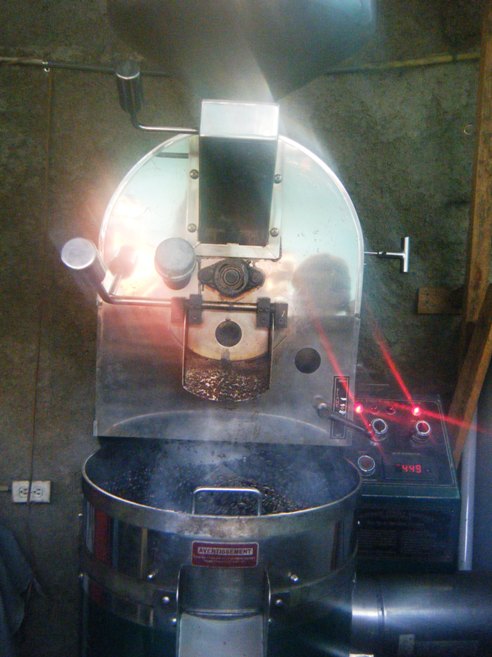
|
When Ronald Reagan ordered the invasion of the small Caribbean nation
of Grenada (not to be confused with Granada, Nicaragua) in 1983, his
excuse was that he was "rescuing" medical students from the United
States that would otherwise be suffering under a new regime. Nobody
really believed him, of course, but U.S. citizens in Nicaragua began
weekly appearances at the U.S. Embassy, repeatedly emphasizing that
fact that they did not need to be rescued from the Sandinista
government. Eventually, in the 1990s, it was decided that the
demonstrations were no longer needed, but the expatriate community
wanted to maintain the weekly contact. By then, Casa Ben Linder had
already been named in honor of the assassinated North American
engineer, and it was decided that the doors would be open to the
international community each Thursday morning.
We were able to time our study tour to end on a Thursday, so that we
could attend the lecture and meet a few of the short-term, long-term,
and permanent visitors who connect through the various programs of the
house. We heard a fascinating presentation about Via Campesino, a
world-wide movement of farmers who have been working to promote
small-scale agriculture as a casualty of -- and an important remedy for
-- global climate change. Because the speaker's arrival was a bit
delayed, our entire group became impromptu
guest speakers, sharing a bit about coffee education at BSU.
|
